HANSA PTFE Machining Parts
You can easily machine PTFE material to make many parts such as:
1.PTFE Ball Valve Seats
The ball valve seat creates a seal between the ball and valve body preventing fluid leakage upon closure. Its design must provide a tight seal upon closure allowing ball rotation freely when the valve is open.
Why Use PTFE
- It has excellent chemical resistance against corrosive substances like acids.
- It is self-lubricating providing a tight seal reducing leakage and minimizing wear and tear on valve components.
- Low coefficient of friction helps reduce the torque requirement in valve operation reducing chances of damage and increasing lifespan.
- PTFE has a high-temperature resistance making it ideal in steam applications of ball valve seats.
- PTFE is a popular material choice for ball valve seats for the following reasons:
Applications
Ball valve seats are utilized in industries such as:
- Chemical and crude oil processing in pipelines.
- Water treatment infrastructure.
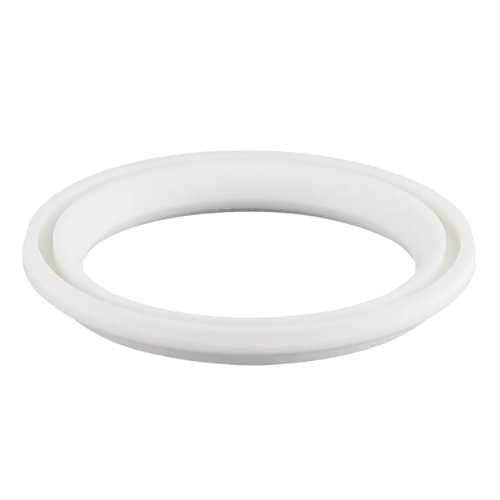

2.PTFE Bushings
A PTFE bushing is a cylindrical component often used to support a rotating shaft or spindle thus reducing friction and wear. It provides a bearing surface that can help to prevent damage to the shaft and other components.
Why Use PTFE
Use of PTFE in bushings is down to its dependable the following reasons:
- It has low friction coefficient.
- PTFE as a material displays relative strength to resist wear caused by movement.
- PTFE is a highly durable material offering longevity of service.
Applications
Bushings find use in many different types of machinery and equipment such as:
- Pumps and motors in automotive engines and industrial machines.
- Household appliances like vacuum cleaners.
3.PTFE Balls
PTFE balls find use in bearings where they are used for their low friction, non-reactive, and durable qualities. Basic design of a bearings consists a sleeve in a housing or fitted over a shaft to create a low-friction surface.
Why Use PTFE
The main advantages of PTFE are:
- PTFE exhibits excellent chemical resistance to aggressive substances making them sufficient in harsh environments.
- Their low coefficient of friction allows them to easily roll or slide over surfaces with minimal resistance.
- They are self-lubricating and not in need of additional lubrication to operate smoothly.
- This material can tolerate high temperatures without deforming.
Application
Some applications of PTFE balls include:
- Automotive engines and transmissions to support rotating components like crankshaft.
- Industrial machinery and equipment such as pumps, compressors, and conveyor systems.
- Aircraft engines, landing gear, and control systems utilize PTFE balls in bearings.

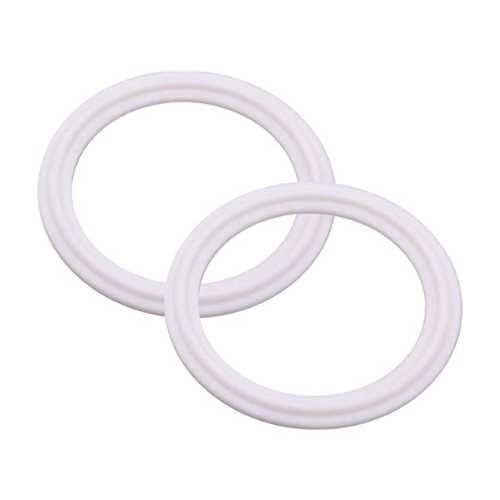
4.PTFE Piston Rings
Piston rings create a tight low friction seal between the piston and the cylinder wall preventing oil entry into the combustion chamber. It also reduces wear and tear on both parts, maintains the engine’s compression improving engine efficiency and reduces fuel consumption.
Why Use PTFE
The benefits of using PTFE piston rings include:
- Their low coefficient of friction reducing wear from persistent use.
- Outstanding chemical resistance to resist damage from engine fluids.
- High-temperature tolerance to thwart the high-heat conditions of the engine.
Application
PTFE piston rings are a common feature in internal combustion engines, compressors, and hydraulic systems.
5.PTFE Valve Bodies
A valve body houses the valve’s internal components and controls the flow of fluid or gas through a piping system. These internal components of a valve body include the valve seat and stem which provide passage to fluids flowing through.
Why Use PTFE
Valve bodies made from PTFE offer the following benefits:
- Can withstand high temperatures without deforming.
- Excellent chemical resistance to aggressive substances.
- PTFE is highly durable and resistant to wear and tear withstanding repeated use without breaking down.
- They have a low surface energy, easily releasing any substances that may adhere to them.
Application
PTFE Valve bodies find use across applications requiring regulation of fluid flow:
- Chemical processing plants regulate substance flow via valve bodies.
- Oil and gas industry utilizes PTFE valve bodies in pipelines and drilling equipment.
- Power plants employ valve bodies in steam flow control through turbines and other equipment.
- Valve bodies are used in food and beverage processing plants to control the flow of raw materials in liquid and gas form.
- Valve bodies are used in water treatment plants to control the flow of water and chemicals like chlorine.
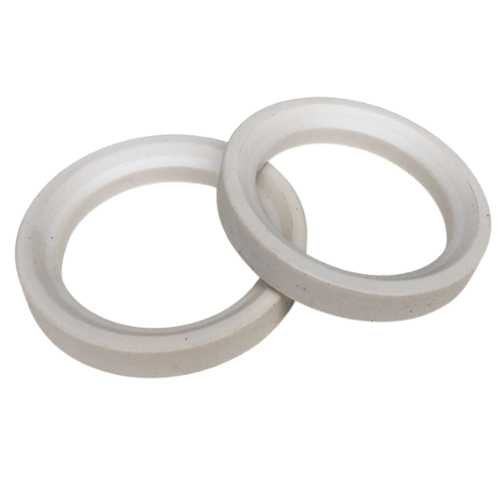

6.PTFE Shaft Seals
Shaft seals are mechanical devices that prevent the escape of fluids from rotating machinery through creating a solid barrier. Typically located where the shaft exits the housing, shaft seals preventing exit of fluids and entry of contaminants.
Why Use PTFE
PTFE offers you the following advantages when used for shaft seals:
- As a highly durable material it offers excellent resistance to chemicals and high temperatures.
- It is also resistant to wear ideally suited to sealing applications.
- It is self-lubricating ideal where there’s limited access for lubrication.
Application
Shaft seals find wide usage including:
- Aircraft engines use shaft seals to prevent leakage of oil and protect against foreign object entry such the Teflon lip seal.
- Food and beverage processing equipment utilize shaft seals in preventing contamination.
- In marine engines, shaft seals prevent the entry of water into the engine compartment.
- Industrial usage in pumps, compressors, and other rotating machinery where they prevent fluid leaks.
- Used in automotive engines to prevent oil leaks from the crank and camshafts.
7.PTFE Wear Strips
Wear strips are mechanical components ideally used between metal-to-metal contacts reducing friction and wear in machinery and equipment. Wear strips can be flat, rounded, or customized and used as guides or supports for moving parts.
Why Use PTFE
- PTFE wear strips offer excellent chemical resistance.
- They’re high temperature tolerant with low friction.
- They are also self-lubricating.
Application
They are commonly used in conveyor systems in packaging equipment and other material handling equipment.


8.PTFE Diaphragms
Diaphragms are flexible membranes used in creating a barrier between two fluids or environments common in pumps, valves, actuators, and pressure sensors. Here, the diaphragm separates the fluid being pumped from the pumping mechanism.
Why Use PTFE
PTFE diaphragms are a popular choice for the following reasons:
- They offer excellent chemical resistance
- Display low friction and high-temperature resistance.
- They are non-stick thus useful with sticky substances and where contamination is sensitive.
Application
- Many pump and valve systems utilize diaphragms made of PTFE.
- The manufacture of fuel cells and batteries.
- Medical and pharmaceutical applications.
9.PTFE Lantern Rings
Lantern rings are a common feature in pumps and other rotating equipment designed to provide lubrication and cooling to the seal. They can be made from different materials and their use prevents damage from friction and subsequently heat.
Why Use PTFE
- PTFE lantern rings offer excellent chemical resistance to corrosive substances.
- Has low friction and high temperature tolerance reducing wear on the mechanical seal.
- Its durability and tolerance levels improve efficiency and reliability.
Application
Lantern rings are a common feature of mechanical seal designs in pump systems across industries.


10.PTFE V-rings
V-rings prevent ingress of dirt, dust, water, and other contaminants into rotating equipment by providing a tight seal against the shaft. They are a type of rotary shaft seal named for their V-shape used in equipment such as bearings or transmissions.
Why Use PTFE
- PTFE withstands exposure chemicals and high temperatures without breaking down.
- This material also offer low friction reducing wear on the shaft thus extending its lifespan.
- Displays high durability improving overall efficiency and reliability.
Application
PTFE V-rings suit usage where the fluid is corrosive, abrasive, or at high temperature as follows:
- V-rings are used in vehicles to seal the rotating shafts of transmissions, engines, and other components.
- Industrial machinery such as pumps, mixers, and gearboxes, use V-rings to prevent contamination and improve efficiency.
- Aircraft engines also employ V-rings to prevent foreign object entry risk engine failure.
- V-rings in farm and construction equipment such as tractors and excavators safeguard the engines by preventing entry of foreign particles.
11.PTFE Gaskets
PTFE gaskets fill the space between two mating surfaces ideally to mechanically prevent leakage. Gaskets can be made from a variety of materials, with PTFE used in case of corrosive or abrasive fluids.
Why Use PTFE
Has excellent chemical resistance and high temperature tolerance. Offers excellent sealing properties for irregular surfaces and small mating gaps.
Its low friction reduces wear on the mating surfaces extending their lifespan.
Application
PTFE gaskets are typically used where the risk of leakage can be costly or hazardous as follows: In,
- Chemical processing machinery
- Oil and gas refining pipelines
- Food and beverage industry machinery
- Automotive engines
Practical gasket examples include expanded PFE gasket tape, PTFE gasket envelope, EPD PTFE gasket, and expanded PTFE gasket.
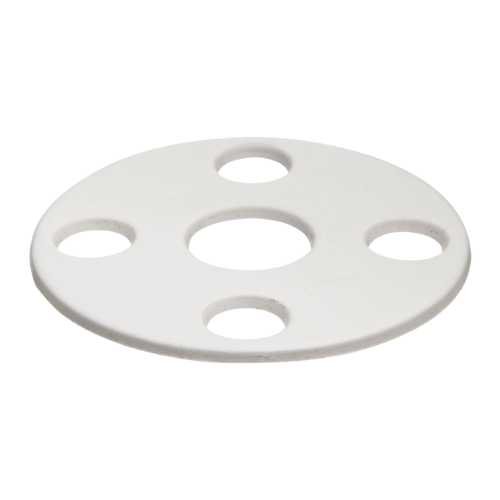

12.PTFE Washers
Washers are thin, flat rings used to distribute the load of a threaded fastener across a larger surface area. A common washer type is a flat washer that takes a circular form with a hole in the center.
Why Use PTFE
- PTFE washers can withstand exposure to high temperatures without deforming.
- Their low friction reduces wear on the threaded fastener and the mating surface extending their lifespan.
- They have excellent chemical resistance well-suited for use in harsh environments.
Application
- Automotive use of PTFE washers is observed in engine assembly and suspension systems preventing damage to mating surfaces.
- Manufacturing application of these washers extends to assembly of machinery and equipment.
- PTFE washers in construction help distribute the bolt and screw load across a wider surface area preventing damage.
- Using washers in plumbing systems like faucets, valves, and pipes prevents leaks providing a watertight seal.
13.PTFE Wafer Dippers
Wafer dippers are specialized tools used in the electronic chip industry for handling wafers during various stages of production. They find use in wet processing applications like cleaning or chemical to hold the wafer securely while minimizing contamination/damage risk.
Why Use PTFE
- It has excellent chemical resistance and low particle generation.
- It is also a highly inert and non-stick material.
Application
Wafer dippers find use in the semiconductor industry.


14.PTFE Adapters
Adapter include straight connectors, elbows, tees, and crosses in different shapes, sizes and end connections for different piping configurations. Adapters connect two or more pieces of piping or tubing and can be threaded or flanged at the ends.
Why Use PTFE
PTFE is favored as adapter material for its chemical resistance and non-stick properties allowing transfer of aggressive fluids.
Applications
- PTFE adapters are utilized in the piping configurations of chemical processing plants, pharmaceutical production, and food and beverage manufacturing.
- They are also used in vacuum systems, where their non-stick properties helps to prevent particle buildup and improve system performance.
15.PTFE Bellows
PTFE bellows are flexible, specially shaped structures used to absorb movements and vibrations in piping systems. Available in different sizes and shapes, they protect components in the piping system from movements and vibrations that could be damaging.
Why Use PTFE
PTFE is highly inert and chemical-resistant making it ideal in corrosive and high-purity applications.
Applications
- PTFE bellows find use in chemical processing, pharmaceutical, and semiconductor industries, where purity and chemical resistance are critical.
- They’re also common in expansion joint applications used in the absorption of thermal expansion or contraction.
- In vacuum systems, PTFE bellows bank on their flexibility to allow for movement of components without breaking the vacuum seal.

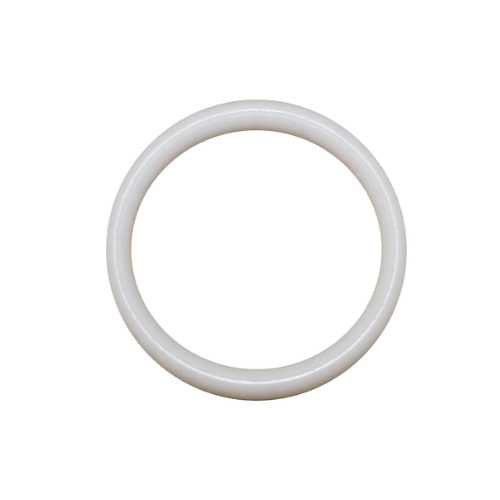
16.PTFE O-rings
PTFE O-rings are circular seals used to prevent leakage of fluids available in different sizes depending on the application. They are named for their shape offering a reliable sealing solution for fluid substances.
Why Use PTFE
- PTFE is displays chemical inertness and resistance while providing tight sealing capabilities.
- They also portray high-temperature tolerance maintaining their original form and sealing performance.
Applications
- O-rings are utilized in aircraft engines and fuel and hydraulic systems.
- Automotive engines and transmission and braking systems all utilize O-rings.
- Pumps, valves, and pipes in food manufacturing and chemical processing plants use O-ring seals.
- O-rings in equipment used in medical devices and pharmaceutical processing prevent contamination.
- Energy plants such as oil and gas refineries and power generation plants used these seal type in their infrastructure.
17.PTFE Gear
Gears are toothed wheels that mesh together to mechanically transfer energy and rotational motion between multiple rotating shafts. There are different gear types depending on design whose number of teeth determine the system’s parameters of speed and torque.
Why Use PTFE
- Gears made from PTFE are highly resistant to wear offering excellent lubricity.
- PTFE is also non-stick and highly resistant to chemicals.
- Its high temperature tolerance allows use in high temperature environments.
Applications
- PTFE gears are a common feature of chemical industries, pharmaceutical production, food and beverage processing and semiconductor manufacturing.
- They are also applicable in high-precision applications like robotics and medical devices.
- PTFE gears serve two main functions: transmission of power over distance and change of rotation speed and direction.
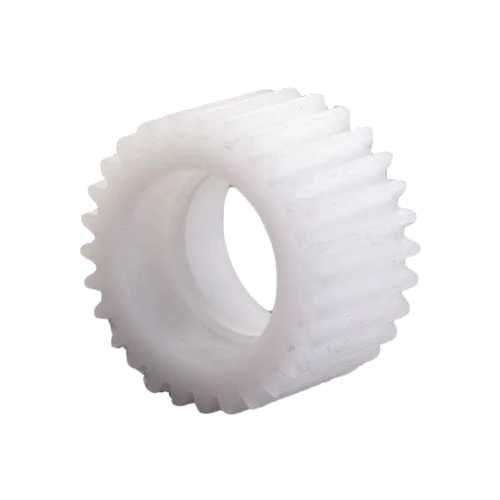

18.PTFE Lid Assembly
A lid assembly describes the closure mechanism utilized on a vehicle’s fuel tank consisting a cover and seal over the opening. Some assemblies may include additional features like a locking mechanism or a venting system preventing pressure buildup inside the fuel tank.
Why Use PTFE
- PTFE offers superb chemical resistance, low friction support, and high temperature resistance ideal in automotive applications.
- PTFE displays excellent sealing property and secure fit preventing leakage or spillage.
Application
PTFE lid assemblies are common in automotive applications and areas where high-performance sealing is desirable.
19.PTFE Air-Box Seat
An air box seat forms a part of the internal combustion engine’s air intake system designed to filter air intake. It fits securely around the air filter in a tight seal preventing dust and other contaminants from entering the combustion chamber.
Why Use PTFE
- PTFE performs relatively formidably at high temperatures and pressures.
- Its performance against aggressive chemicals is outstanding.
Application
Air box seats made from PTFE find use in high-performance engines requiring clean and consistent airflow. This ensures efficiency and achievement of maximum power while reducing engine noise and improving throttle response.


20.PTFE Nozzles
A nozzle controls the flow of a fluid by converting flow pressure and velocity into a desired pattern or direction. These nozzles can encompass different designs resulting in several types like spray nozzles, jet nozzles, and atomizing nozzles.
Why Use PTFE
- PTFE displays great resistance to chemicals and high-temperature conditions.
- The low friction coefficient allows for efficient release of fluid through the nozzle.
- Their non-stick properties makes them easy to clean and maintain.
Applications
- Chemical processing industries use nozzles for executing mixing applications, dosing, and spraying chemicals.
- Fire hoses use nozzles to control the flow and direction of water or foam for fire extinguishing.
- Internal combustion engines utilize nozzles for their fuel injection systems to atomize the fuel before mixing with air and burning.
- Nozzles in inkjet printers allow for precise and controlled delivery of ink onto paper or other media.
- Rocket and jet engines utilize nozzles to control the direction and velocity of exhaust gases for thrust.
21.PTFE Manifolds
A manifold is a feature that distributes or collects fluid from multiple sources to multiple destinations. They can have different designs to meet the application needs and formed of different materials like plastic and PTFE.
Why Use PTFE
Polytetrafluoroethylene is used in manifolds for its excellent chemical resistance, thermal stability, and non-stick properties. This prevents wear and damage of the manifold from interacting with the fluid substance.
Applications
- PTFE manifolds find wide usage in chemical processing applications to distribute or collect corrosive chemicals.
- Water treatment plants utilize PTFE manifolds in the distribution or collection of water.
- Medical devices like dialysis machines and blood oxygenators employ PTFE manifolds in moving fluids and gases.
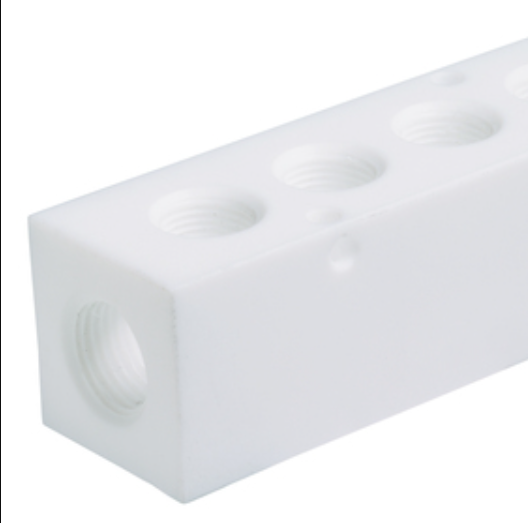

22.PTFE Plug Valve Sleeves
Plug valve sleeves are cylindrical inserts lining inner walls of plug valves acting as seals and preventing direct contact with fluid. Plug valves are flow control devices utilizing a tapered or cylindrical plug in the regulation of fluid flow through a pipeline.
Why Use PTFE
- PTFE plug valve sleeves offer impressive resistance to temperature and chemical induced corrosion.
- PTFE also displays non-sticking property keeping the inner walls of plug valves free from substance reducing chances of blockage.
Applications
- Plug valve sleeves find use in plug valves which are useful flow control devices used in various industries. These include chemical and petrochemical plants, oil and gas plants and wastewater treatment plants.
- They are also common in frequently operated applications requiring tight shutoffs like pipelines and storage tanks.
23.PTFE Ferrules
Ferrules are tiny sleeves that are versatile components used to secure and protect wire ends, cables, or tubes. They can be crimped or screwed onto the terminations of a wire or cable creating a secure, permanent connection.
Why Use PTFE
Some of the benefits of using PTFE for ferrules include:
- PTFE is highly resistant to different chemicals such as acids making them ideal in case ferrules interact with such harsh chemicals.
- The temperature resistance level of PTFE is immense with the capacity to withstand extreme temperature ranges.
- PTFE displays non-stick property preventing attachment of adhesive substances and coatings on ferrules that can cause build-up.
- PTFE displays excellent electrical insulation properties useful in preventing the flow of electrical currents between components.
- The durability of PTFE is highly acclaimed thanks to its wear and tear resistance wreathing and UV tolerance.
Application
PTFE ferrules find common use in industrial and electrical applications where wires, cables or tubes need to be secured or connected.




